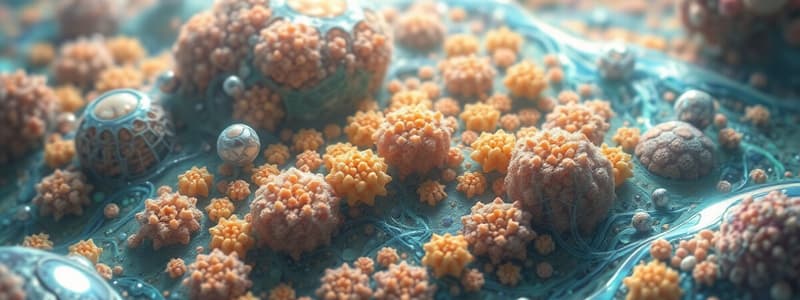Podcast
Questions and Answers
What is the first step in the formation process of a biofilm?
What is the first step in the formation process of a biofilm?
- Irreversible Attachment
- Dispersion
- Maturation
- Initial Attachment (correct)
Which of the following statements about biofilms is true?
Which of the following statements about biofilms is true?
- Biofilms only consist of bacteria.
- Biofilms only form in aquatic environments.
- Biofilms do not have a complex structure.
- Biofilms can be found in both natural and engineered environments. (correct)
What is a characteristic benefit of biofilms?
What is a characteristic benefit of biofilms?
- Enhanced nutrient acquisition (correct)
- Simpler community structure
- Increased vulnerability to antibiotics
- Reduced metabolic capabilities
What process involves cells detaching from a biofilm to colonize new areas?
What process involves cells detaching from a biofilm to colonize new areas?
Which method is commonly used for detecting biofilms?
Which method is commonly used for detecting biofilms?
What challenge do biofilms pose in medical settings?
What challenge do biofilms pose in medical settings?
Which of the following is NOT a step in the biofilm formation process?
Which of the following is NOT a step in the biofilm formation process?
What is one reason chemical treatments may be less effective against established biofilms?
What is one reason chemical treatments may be less effective against established biofilms?
What role do extracellular polymeric substances (EPS) play in biofilms?
What role do extracellular polymeric substances (EPS) play in biofilms?
Which of the following microorganisms can be part of a biofilm?
Which of the following microorganisms can be part of a biofilm?
Flashcards are hidden until you start studying
Study Notes
Definition
- A biofilm is a collection of microorganisms that adhere to surfaces and each other, typically embedded in a self-produced matrix of extracellular polymeric substances (EPS).
Characteristics
- Can be composed of bacteria, fungi, algae, and protozoa.
- Commonly found in natural environments (e.g., rivers, oceans) and engineered systems (e.g., pipes, medical devices).
- Display complex community structure and organization.
Formation Process
- Initial Attachment: Microorganisms adhere to a surface.
- Irreversible Attachment: Cells begin to produce EPS, anchoring them more securely.
- Maturation: Biofilm structure develops with channels for nutrient and waste transport.
- Dispersion: Cells detach from the biofilm to colonize new areas.
Benefits
- Enhanced survival due to protection from environmental stresses (e.g., antibiotics, disinfectants).
- Improved nutrient acquisition due to cooperative interactions among microorganisms.
- Enhanced metabolic capabilities.
Challenges
- Biofilms can lead to problems in industrial settings (e.g., clogging pipes).
- Medical issues such as infections in implants (e.g., catheters, prosthetic devices).
Detection and Analysis
- Common methods include microscopy, culturing techniques, and molecular methods (e.g., PCR for specific species).
Control and Treatment
- Physical methods: removal or disruption through scraping, ultrasonic waves.
- Chemical methods: use of biocides or antibiotics, although these can be less effective against established biofilms.
- Biological methods: employing bacteriophages or enzymes that target biofilm components.
Biofilms: Key Concepts
- A biofilm is a community of microorganisms living in a matrix of slime. This slime is made of extracellular polymeric substances (EPS).
- Biofilms can be found in diverse places from natural settings like rivers and oceans, to artificial environments like pipes and medical implants.
- Biofilms can be made up of various microbes such as bacteria, fungi, algae, and protozoa.
- Biofilm formation is a complex process that follows a sequence of steps:
- Initial attachment: Microorganisms initially adhere to a surface.
- Irreversible attachment: Once attached, cells produce EPS, which strengthens their hold.
- Maturation: The biofilm grows in structure, developing channels for nutrient and waste exchange.
- Dispersion: Cells may detach from the biofilm to form new ones.
- Microorganisms within biofilms gain numerous advantages:
- They are better protected against environmental stresses like antibiotics and disinfectants.
- By working together, they improve their ability to acquire nutrients.
- They gain access to diverse metabolic functions.
Biofilm Challenges
- Biofilms can cause problems in industrial settings, like clogging pipes.
- In medicine, biofilms are a major cause of implant infections, impacting devices like catheters and prosthetic implants.
Studying Biofilms
- Biofilms can be detected and analyzed through various methods:
- Microscopy: Allows visualization of biofilm structure.
- Culturing techniques: Enable researchers to grow and isolate microorganisms.
- Molecular methods: Techniques like PCR can identify specific species within a biofilm.
Controlling Biofilms
- Biofilms can be controlled in a number of ways:
- Physical methods: Physical removal methods include scraping and ultrasound.
- Chemical methods: Biocides and antibiotics can be used, but their effectiveness can decline against established biofilms.
- Biological methods: Bacteriophages (viruses that kill bacteria) or enzymes that target biofilm components can be employed.
Studying That Suits You
Use AI to generate personalized quizzes and flashcards to suit your learning preferences.




